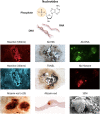From organic and inorganic phosphates to valvular and vascular calcifications
- PMID: 33576771
- PMCID: PMC8318101
- DOI: 10.1093/cvr/cvab038
From organic and inorganic phosphates to valvular and vascular calcifications
Abstract
Calcification of the arterial wall and valves is an important part of the pathophysiological process of peripheral and coronary atherosclerosis, aortic stenosis, ageing, diabetes, and chronic kidney disease. This review aims to better understand how extracellular phosphates and their ability to be retained as calcium phosphates on the extracellular matrix initiate the mineralization process of arteries and valves. In this context, the physiological process of bone mineralization remains a human model for pathological soft tissue mineralization. Soluble (ionized) calcium precipitation occurs on extracellular phosphates; either with inorganic or on exposed organic phosphates. Organic phosphates are classified as either structural (phospholipids, nucleic acids) or energetic (corresponding to phosphoryl transfer activities). Extracellular phosphates promote a phenotypic shift in vascular smooth muscle and valvular interstitial cells towards an osteoblast gene expression pattern, which provokes the active phase of mineralization. A line of defense systems protects arterial and valvular tissue calcifications. Given the major roles of phosphate in soft tissue calcification, phosphate mimetics, and/or prevention of phosphate dissipation represent novel potential therapeutic approaches for arterial and valvular calcification.
Keywords: Ageing; Atherosclerosis; Exosomes; Smooth muscle cells; Aortic stenosis.
© The Author(s) 2021. Published by Oxford University Press on behalf of the European Society of Cardiology.
Figures







Comment in
-
Platelets, coagulation, and the vascular wall: the quest to better understand and smarten up our therapeutic targeting of this triad in primary and secondary prevention of cardiovascular events.Cardiovasc Res. 2021 Jul 27;117(9):1998-2000. doi: 10.1093/cvr/cvab121. Cardiovasc Res. 2021. PMID: 33792665 No abstract available.
Similar articles
-
Oxyphospholipids in Cardiovascular Calcification.Arterioscler Thromb Vasc Biol. 2021 Jan;41(1):11-19. doi: 10.1161/ATVBAHA.120.313790. Epub 2020 Nov 24. Arterioscler Thromb Vasc Biol. 2021. PMID: 33232199 Review.
-
2020 Jeffrey M. Hoeg Award Lecture: Calcifying Extracellular Vesicles as Building Blocks of Microcalcifications in Cardiovascular Disorders.Arterioscler Thromb Vasc Biol. 2021 Jan;41(1):117-127. doi: 10.1161/ATVBAHA.120.314704. Epub 2020 Oct 29. Arterioscler Thromb Vasc Biol. 2021. PMID: 33115271 Free PMC article. Review.
-
Gla-rich protein acts as a calcification inhibitor in the human cardiovascular system.Arterioscler Thromb Vasc Biol. 2015 Feb;35(2):399-408. doi: 10.1161/ATVBAHA.114.304823. Epub 2014 Dec 23. Arterioscler Thromb Vasc Biol. 2015. PMID: 25538207
-
Ectopic calcification: new concepts in cellular regulation.Z Kardiol. 2001;90 Suppl 3:31-7. doi: 10.1007/s003920170039. Z Kardiol. 2001. PMID: 11374030
-
Retinoids Repress Human Cardiovascular Cell Calcification With Evidence for Distinct Selective Retinoid Modulator Effects.Arterioscler Thromb Vasc Biol. 2020 Mar;40(3):656-669. doi: 10.1161/ATVBAHA.119.313366. Epub 2019 Dec 19. Arterioscler Thromb Vasc Biol. 2020. PMID: 31852220 Free PMC article.
Cited by
-
PTP1B Inhibition Improves Mitochondrial Dynamics to Alleviate Calcific Aortic Valve Disease Via Regulating OPA1 Homeostasis.JACC Basic Transl Sci. 2022 Jul 25;7(7):697-712. doi: 10.1016/j.jacbts.2022.03.002. eCollection 2022 Jul. JACC Basic Transl Sci. 2022. PMID: 35958694 Free PMC article.
-
The mechanistic pathways of oxidative stress in aortic stenosis and clinical implications.Theranostics. 2022 Jul 4;12(11):5189-5203. doi: 10.7150/thno.71813. eCollection 2022. Theranostics. 2022. PMID: 35836811 Free PMC article. Review.
-
Focusing on the Native Matrix Proteins in Calcific Aortic Valve Stenosis.JACC Basic Transl Sci. 2023 Mar 29;8(8):1028-1039. doi: 10.1016/j.jacbts.2023.01.009. eCollection 2023 Aug. JACC Basic Transl Sci. 2023. PMID: 37719438 Free PMC article. Review.
-
Association Between Serum Phosphate Levels and Progression of Aortic Stenosis.JACC Adv. 2024 Jul 6;3(8):101096. doi: 10.1016/j.jacadv.2024.101096. eCollection 2024 Aug. JACC Adv. 2024. PMID: 39050812 Free PMC article. No abstract available.
-
CDK1 inhibition reduces osteogenesis in endothelial cells in vascular calcification.JCI Insight. 2024 Mar 8;9(5):e176065. doi: 10.1172/jci.insight.176065. JCI Insight. 2024. PMID: 38456502 Free PMC article.
References
-
- Watson JD, Crick FH.. Molecular structure of nucleic acids: a structure for deoxyribose nucleic acid. J.D. Watson and F.H.C. Crick. Published in Nature, number 4356 April 25, 1953. Nature 1974;248:765–765. - PubMed
-
- Lipmann F. The roots of bioenergetics. Ciba Found Symp 1975;31:3–22. - PubMed
-
- Westheimer FH. Why nature chose phosphates. Science 1987;235:1173–1178. - PubMed
Publication types
MeSH terms
Substances
Grants and funding
LinkOut - more resources
Full Text Sources
Other Literature Sources
Medical

